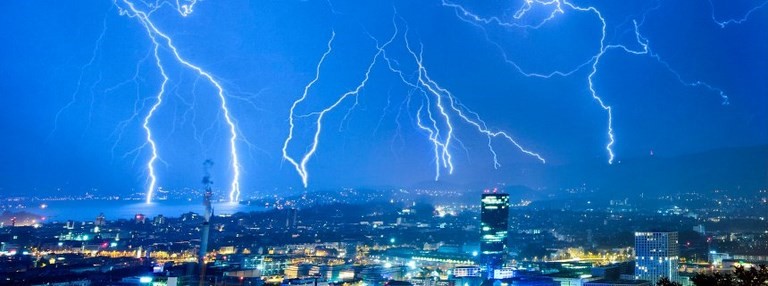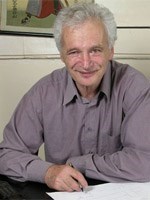Lightning Triggered by Cosmic Rays
The Runaway-Breakdown Theory

Lightning over Zürich
A life-endangering experiment taking place over 250 years ago gave us our basic knowledge about lightning: in 1752, Benjamin Franklin let a kite fly into a thundercloud at the end of a wet twine. When sparks flew, and when, with the twine connected by way of a key to a Leyden jar he found that the latter had become charged, Franklin knew what he was dealing with: an electrical phenomenon.
Other experimenters lost their lives to electrocution while carrying out such experiments, beginning with the German physicist Georg Wilhelm Richmann in Saint Petersburg, one year later. Yet, despite life-endangering missions and the use of modern satellites, we do not know that much more about atmospheric lightning as was known in Franklin’s times. But scientists have been recently adducing circumstantial evidence in favor of a surprising theory explaining how lightning is triggered: these high-powered, 30,000°C slingshots hurled around the atmosphere are ignited by cosmic radiation, Russian scientists announced in the scientific publication Physical Review Letters. (See abstract.)
The greatest mystery since Franklin’s time has always been: how do these enormous electric tensions build up in the atmosphere? What powers can possibly be at work, separating positively and negatively charged particles, causing high-power discharges to shoot through the air at a speed of 360 million km/h, and at temperatures four times higher than that of the surface of the Sun?
It has been established by measurements that storm clouds are charged negatively on the downside, positively on the upside. The greater the difference in charge between the two, the greater the tension - and the more powerful the lightning discharge.
Powerful updrafts had been up to now considered to provide the explanation for why charged particles of air divide: winds would be wipping raindrops and particles of ice present in a stormcloud, conveying them upwards at a speed of 200km/h as if through a chimney flue. Friction occurs among the particles, which separate into positive and negative particles - or so goes the current theory taught in manuals.
The power of such updrafts has been experienced by many a parachute devotee: in 1982, an Australian, Rick Collins, found himself pulled up almost to 4,000 m. In a desperate attempt to stop his ascension, he tore off his parachute, abandoned himself to a freefall through the cloud and, arrived at some 400m from the ground, opened his reserve parachute - and landed securely in the middle of a crashing thunderstorm.
Yet the fact that updrafts are producing the electric tension has never been proven. Russian scientists Alex Gurevich of the Russian Academy of Sciences and Anatoly Karashtin of the Institute of Radiophysics Research of Nijni-Novgorod recently presented for the first time scientific proof for another theory: according to which it is cosmic radiation which triggers lightning - winds do not play a crucial role.
According to their theory, stormclouds, sometimes several kilometers high, consitute a perfect target for the steady bombardment of charged particles from space pattering down on Earth: it is these particle storms which tear apart the cloud particles, triggering a destructive chain reaction: negatively charged particles shoot out to all sides like runaways, crash into raindrops, tear them apart, so that thousands and thousands of new charged particles are being created. When the cloud reaches several thousand volts, lightning bolts lash out to equalize the tension.
The hypothesis in itself is not new, other scientists have considered it plausible, Gurevich himself had proposed this theory which he named the runaway-breakdown initiation of lightning. But proof had been hitherto lacking. If the theory was correct, Gurevich and Karashtin recognized, short pulses of radiowaves triggered by the cascade of cosmic radiation would have to shoot earthwards. And indeed: an analysis of 3,800 lightning bolts over Russia and Kazakhstan has yelded its results: in the moments preceding lightning, stormclouds emit hunderts of radiowave signals.
When the data was analyzed, their pattern matched that predicted by the models of runaway-breakdown, but the pulses were too big to be produced by regular cosmic rays. Gurevich and Karashtin explain that every storm cloud has tiny charged ice particles called hydrometeors, and think that they might be amplifying the pulses. Their calculations seem to confirm this: when a large amount of free electrons – created in a runaway breakdown process initiated by cosmic rays - collect near these hydrometeors, they boost the current and observed radio pulse signal.
"It’s an interesting observation", comments Julian Rautenberg, an astrophysicist at the University of Wuppertal, who is also studying the phenomenon. Now it remains to be proven if the radiowaves are effectively triggered by cosmic radiation. The study has not investigated whether more powerful showers of cosmic radiation precede the lightning bolts, adds his colleague Karl-Heinz Kampert from the University of Wuppertal. It is possible therefore that the radiowaves might have another cause.
A large-scale experiment at the Pierre-Auger Observatory in the desert of Argentina must now solve this problem: the Wuppertal scientists are participating there to the building of a large field of antennas, which is meant to measure cosmic radiation with great precision. Hope is rising that the mystery of lightning will be solved before Franklin’s experiments reach their 300th anniversary...
From an article by Axel Bojanowsky
DER SPIEGEL - May 7, 2013
translated and expanded by Anne-Marie de Grazia
Runaway-Breakdown: a paper by Alex Gurevich

This paper was published by Alex Gurevich in Physics Today in May 2005, before the proofs mentioned above had become available.
Go to: Runaway-Breakdown: The Mysteries of Lightning (Stanford U.)

